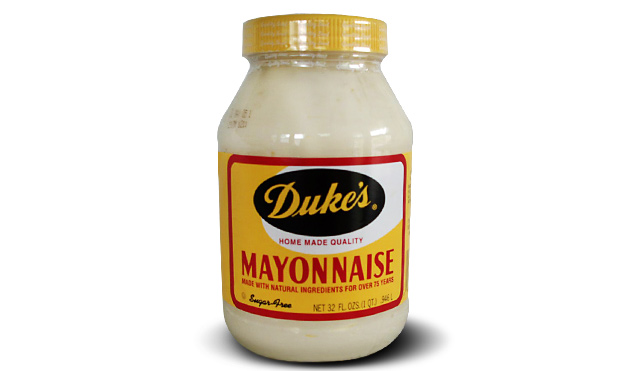Week 31: Put Up Your Duke’s
At a humble sandwich counter at a fishing pier in coastal Carolina, the following conversation takes place:
“Can I help you?”
“Yes, two BLT’s please.”
“Bread?”
“Both on wheat toast”
“Aw right. You want any Duke’s on those?”
Pause…
OK, here’s what you need to know about the condiment business in the United States. First, most folks equate the word “condiment” with a bottle that says “Heinz” on it. And that’s understandable, Heinz Ketchup has been an icon since it was launched in Pittsburgh in 1879. Heinz has a stranglehold on the ketchup business, with a ridiculous 75% share of the market. It’s the king of condiments.
Or, maybe not.
There was a recent cultural shift – unnerving to some folks – that resulted in a well-publicized moment a few years back. Somebody reported that ketchup sales had been for the first time outpaced by *GASP* sales of salsa! It was evidence of the impact of Hispanic immigrants on America, and our adoption of that culture. What wasn’t reported, however, is that the vast majority of salsa sold in this country is produced by mainstream American corporations, NOT by Hispanic companies themselves. The number one brand of salsa? That would be Tostitos, from Frito-Lay, the #2 condiment brand in the United States, just ahead of Heinz ketchup.
Which raises the question: which condiment brand is #1? Well, it would probably give it away to say the product was invented by a Jewish deli owner in New York in 1905. The product was so popular that by 1917 the owner had closed his deli to focus exclusively on selling it as “Hellman’s Blue Ribbon Mayonnaise.” In 1932, his company was purchased by California-based Best Foods corporation, who had their own mayo brand. But Best Foods respected the power of the Hellman’s brand so much that they aligned their brand to look just like it. This created a unique double-brand platform that has endured ever since. Some of you may have experienced, when you traveled from one coast to the other, you might have heard the jingle, “Bring out the Hellman’s and bring out the best” when you left New York, and then the nearly EXACT same jingle, “Bring out the Best Foods and bring out the best” when you arrived in LA. These two brands, now both owned by Unilever, are the #1 and the #4 condiment brands in the United States. Together with Kraft Mayo (#6) and Kraft Miracle Whip (#5) they are evidence of America’s overwhelming love of mayonnaise.
Which brings us back to this thing called Duke’s. It’s a tiny brand, just a schmear of the mayo market. It was invented in 1917 by Eugenia Duke of Greenville NC, who used it on sandwiches she sold to soldiers at the nearby Fort Sevier. When it was packaged in jars, Duke’s Mayonnaise was a huge hit, and the brand was bought by C.F. Sauer company of Richmond in 1929. But the manufacturing has remained in Greenville to this day, and Eugenia Duke’s recipe is unchanged. It uses more egg yolks than other brands and is the only mayo made without sugar, giving it a richness and a distinctive acidic tang all its own. No self-respecting southerner would make deviled eggs, potato salad or any sandwich at-all using anything else.
Until recently, Duke’s was only available in the southern states. But, shortly after its 100th birthday in 2017, Duke’s was acquired by some wealthy investors, who gave it a new ad campaign, rolled out lots of line extensions, expanded distribution, and even gave the brand its own football bowl game in Charlotte.
So now you can find it in lots of places. Down here, it’s got shelf prominence in the Food Lion and at Lowes. Up north, we now have it in our Pennington Market IGA.
But if you really want to enjoy this stuff, if you want the real deal, there’s still only one place to go.
C’mon y’all. Take a drive over to the Piggly-Wiggly.
